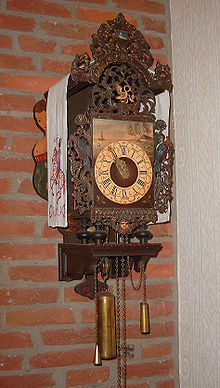Stoelklok

The Dutch Stoelklok (also Stoolklok or Stoeltjesklok ; Dutch for: chair clock ) is a weight-driven wall clock with a short pendulum, in which the clockwork with small feet is raised and free on a so-called chair, usually a console made of wood. This type of clock was very common in the Netherlands in the 17th and 18th centuries. The chair clock is closely related to the lantern clock .
The smallest versions, with only one movement and one alarm mechanism , are among the oldest chair clocks. There are different regional versions of this type of watch in the Netherlands.
Friesian Stoelklok
The Friese Stoelklok was produced all over Friesland , with the town of Grouw in the municipality of Boornsterhem, with its watchmaking trade that was pronounced in the 18th century, as its origin. Typical of the Frisian chair clock are a richly painted dial with gold-plated decorations on the sides , mermaids on the shelf and many gold-plated lead or brass decorations . In addition to the striking mechanism on a bell, some copies also had calendar or automatic musical mechanisms. The production of the Stoelklok began in the 18th century, but was later replaced by the "Frisian Staartklok". A very related type of clock came from the province of Groningen ( Groninger Stoelklok ).
Zaanse Stoelklok
The Zaanse Stoelklok was originally produced from 1680 to 1730 along the Zaan , a river near Amsterdam . There are hardly any paintings on Zaanse clocks and the dial was covered with black cloth and later with velvet . On the bell there is a figure of the titan Atlas , who carries the globe. The design of the historical Zaanse clocks was and is very popular and until the 20th century, replicas were produced in large quantities, especially in the Black Forest , and exported to the Netherlands. Original pieces, on the other hand, are rarely found.
Schippertje
Chair watches were also in the Netherlands on barges used and then schippertje or Tukkertje called. Due to the short pendulum, which is directly connected to the horizontal spindle escapement in these clocks , they were relatively imprecise but insensitive to the fluctuations of the ship. A quiver placed below the clock prevented the weight from rolling.
literature
- J. Zeeman: De Nederlandse Stoelklok . Van Gorcum Assen, Amsterdam (NL) 1978. ISBN 978-9023214168 .
- Jan Willem Voogd: Antieke Nederlandse Klokken , Scriptum Art, Schiedam, 2007.
Web links
Individual evidence
- ^ C. Spierdijk: Klokken en Klokkenmakers . de Bussy, Amsterdam (NL) 1965.
